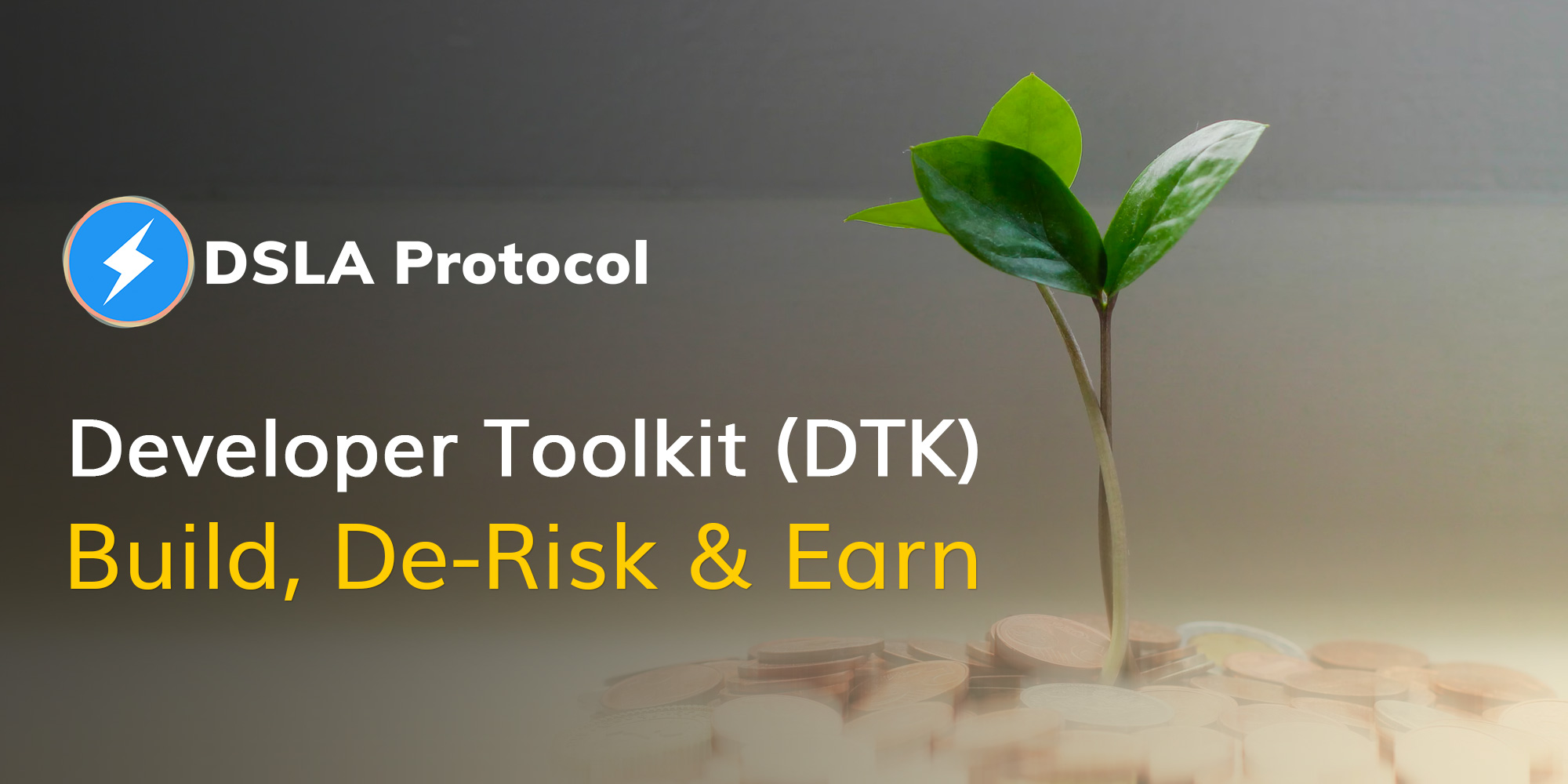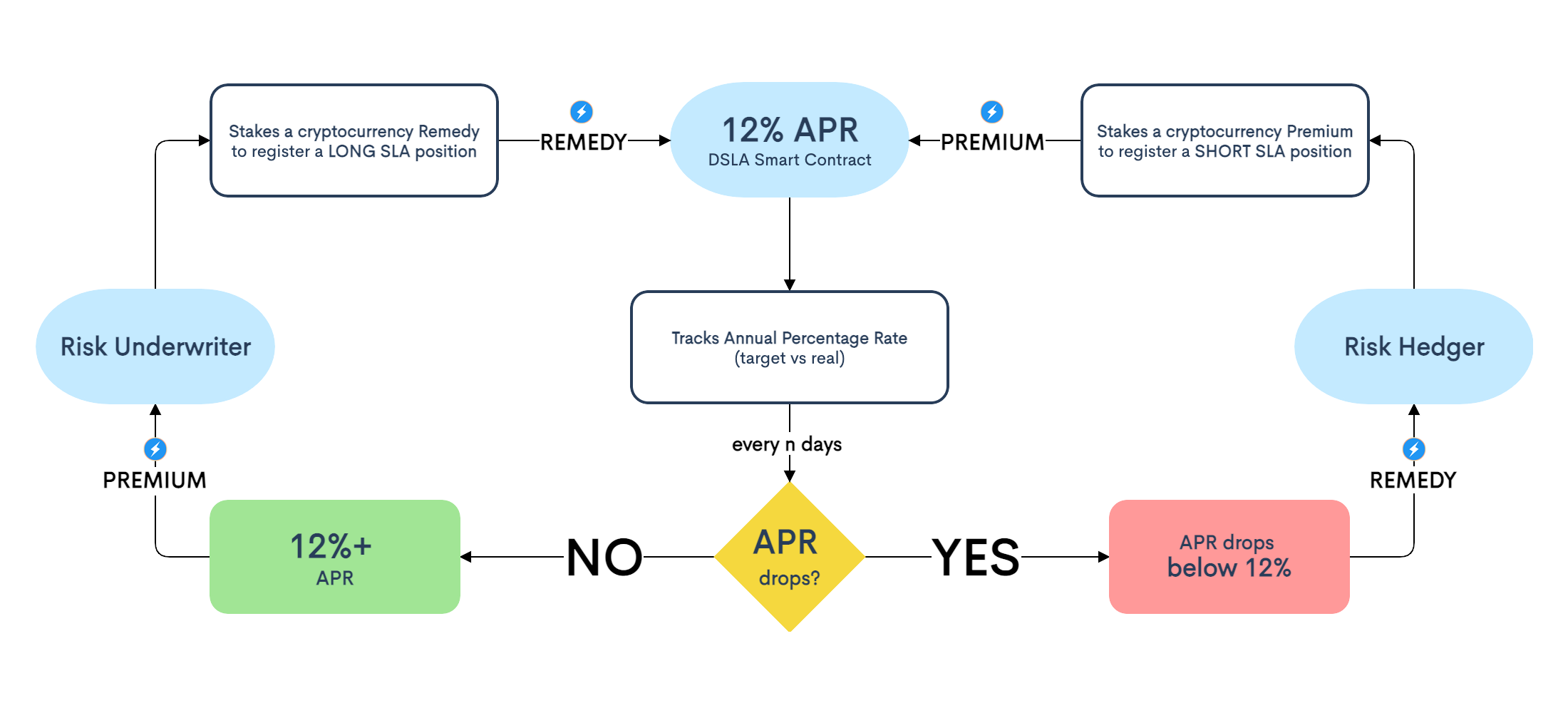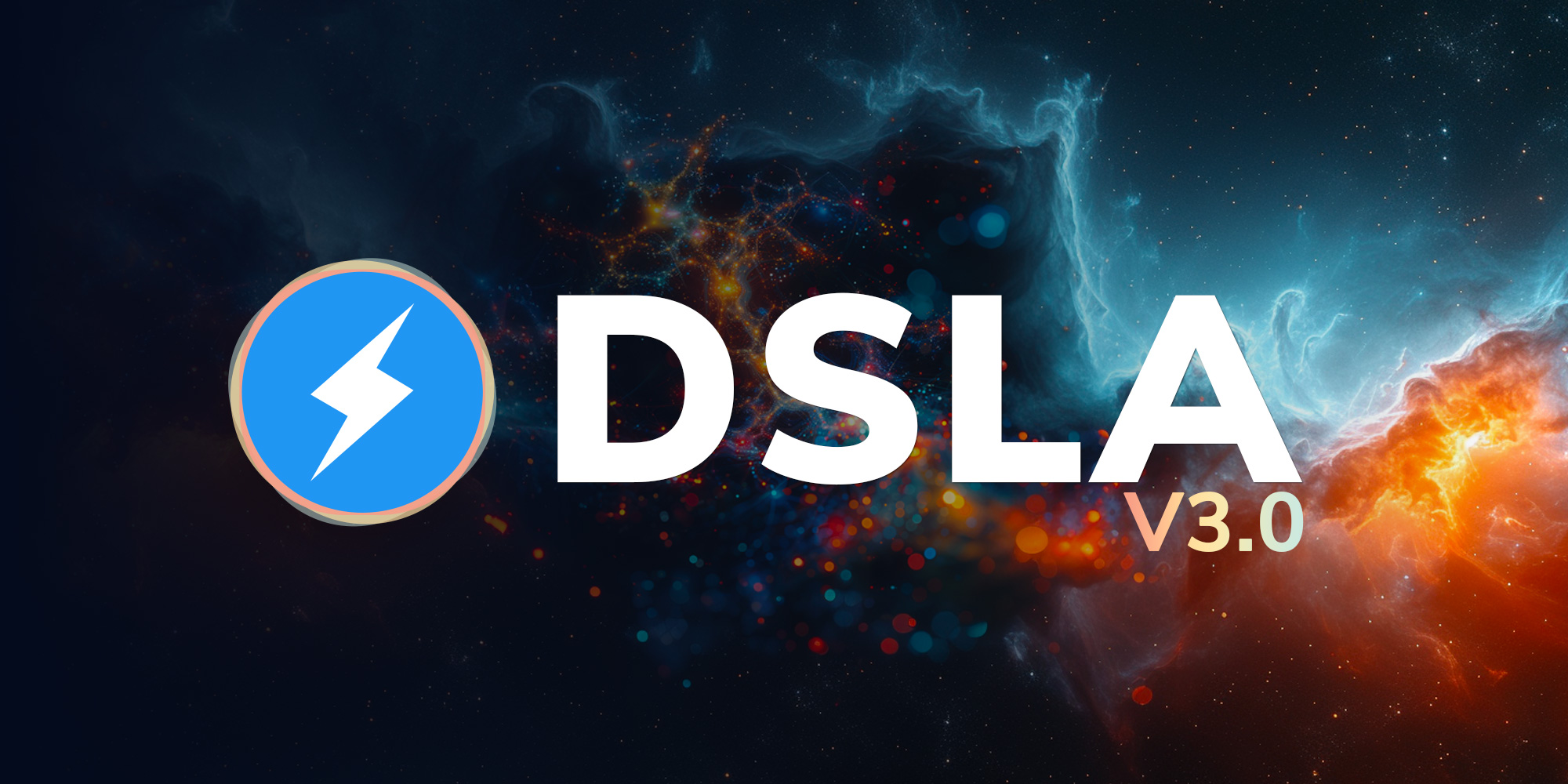Build on the world's first L0 Insurance Protocol

Insurtech as a Service, powered by Decentralized SLAs
The DSLA Protocol core team is proud to announce the release of the DSLA Protocol Developer Toolkit (DTK) and the DSLA Protocol Developer Guide.
The DTK empowers developers to build new use cases and risk aware applications using DSLA Protocol, and the Developer Guide is there to help you get started!
Value Proposition for Developers
Why build on DSLA Protocol?
First, developers are able to add custom, peer-to-peer risk management capabilities to their existing applications, networks and services. These capabilities will increase user confidence, leading to higher product adoption and retention.
Second, developers can provide liquidity to the service-level agreements they create themselves, to earn additional revenue when application, network and service performance targets are met.
Last but not least, DSLA is a programmable protocol with built-in incentives for developers. Developers who create new use cases (tldr: new types of service-level agreements) earn a share of verification fees that are generated by that use case forever.
SLA Verification fees are distributed as follows:
-
👩💻 25% to the developer who built the SLA
-
🤲 25% to the user doing the SLA verification
-
🏠 25% to the DSLA treasury
-
🔥 25% burned forever
Every time someone requests a verification of a SLA, the creator of the Messenger contract receives a reward from the SLA contract creator (part of the verification fee), managed by the DSLA protocol in a decentralized fashion.
What is a Use Case 🤔 ?
A use case is a real world situation where DSLA Protocol can be integrated to provide risk management capabilities.
On the technical side, in DSLA Protocol a use case is the combination of smart contracts, an Oracle middleware and data sources.

Every use case can be broken down into four primary components:
-
Messenger contract: It relays the messages between Chainlink and an SLA contract. A messenger defines how to query for data to the Chainlink infrastructure and network of Chainlink node operators.
-
Oracle/Precoordinator contract: This contract defines the Chainlink node operators that are allowed to fulfill requests.
-
Chainlink node: A service that awaits for onchain events to fetch third-party analytics. In this case, a Chainlink bridge is used to call an External adapter.
-
External adapter: A Chainlink external adapter is a API endpoint that can be called by a Chainlink node. It’s packaged in the DTK as a serverless function. This serverless function is in charge of fetching third-party analytics, compute performance parameters and return a SLI measurement to the SLA contract.
Example Use Cases
Below are the main DeFi related use cases that the DSLA Protocol core team are currently focused on, with APR/APY SLAs and Uptime SLAs already active on the flagship DSLA.network dApp.
| USE CASE | DESCRIPTION |
|---|---|
| APR/APY SLA | Hedge against diminishing staking returns and yields |
| Uptime SLA | Hedge against application, network and service downtimes |
| Response Time SLA | Hedge against slow application, network and service |
| Withdrawal Time SLA | Hedge against third party custodian lock-up |
| Impermanent Loss SLA | Hedge against negative market making returns |
| Peg SLA | Hedge against stablecoin and synthetic assets losing their peg |
However, DSLA Protocol is compatible with any application, network and service with measurable performance. In any industry.
Getting started with the Developer Toolkit (DTK)
Let’s go over some steps from the Setup and Quick Start sections of our Developer Guide to see how to quickly spin up the DTK on your local machine and get BUIDLing.
We highly recommend you check out the Developer Guide and read it in it’s entirety!
DTK Walkthrough
Prerequisites:
- docker-compose
- Hardhat (can be added with
npm install --save-dev hardhat) - Node.js version 16.13.0 LTS
- npm version 7.21.1
Quick start
You are going to end up with two console tabs open at then end of this walkthrough.
- One that is your main working tab for the DTK repo (stacktical-dsla-developer-toolkit)
- One for running the external adapter (for your local Chainlink node)
Okay, let’s go!
First, install Hardhat shorthand
npm i -g hardhat-shorthand && hardhat-completion install
Clone the DTK repo. You can check it out here
git clone https://github.com/Stacktical/stacktical-dsla-developer-toolkit.git
Make sure to switch into the cloned DTK repository folder, then run npm install
cd stacktical-dsla-developer-toolkit
npm install
Some users may have
npm installthrow an error while installingassemblyscript. A suggested workaround for this is usingnpm install assemblyscriptseparately to install assemblyscript. Confirm success by runningnpm installagain, which should then complete with no errors.
Next copy the env-min file to create your folder .env file
cp env-min .env
You will note that there are a lot of variables in the .env file, because Hardhat checks for them based on data from
hardhat.config.ts; if any of these variables are not present you will have errors thrown in later steps of this guide while trying to load the DTK. However, as long as the variables are present, they may be empty or set to dummy values, as is the case for most of the variables in env-min.
Set your console to use the .env file as the source for environment variables.
source .env
Prior to running the next command, ensure that the
index.tsfile in thestacktical-dsla-developer-toolkit/networkshas thedevelopnetwork enabled. The develop network flag on line 4 should read{ name: NETWORKS.DEVELOP, enabled: true },
Next, we will deploy local services for the ‘develop’ network including the local develop blockchain and IPFS node. Run the folling command to do so:
hh stacktical:restart-services --network develop
In a separate console tab navigate to your local DTK repo and run the following command to spin up your local external adapter:
npm run external-adapter
The external adapter code can be found in the
servicesfolder under theexternal-adaptersubfolder. It contains code for a simple Express.js app and can be modified to implement the logic of an indexer for a new use case.
Switch back to your working tab.
Now that services are running, we can deploy our contracts and Chainlink nodes using hh deploy with the following command:
hh deploy --network develop --reset
This will clean any previous deployment of the ‘develop’ network and run the Chainlink nodes locally. You may run into a permissions error on the /services/chainlink-nodes or the /services/graph-protocol/postgres folders if you run the
hh deploycommand multiple times. If so, run the below commands to ensure permissions on these folders
sudo chown -R YOUR_USER: /home/your_path_to_DTK/stacktical-dsla-developer-toolkit/services/chainlink-nodes
sudo chown -R YOUR_USER: /home/your_path_to_DTK/stacktical-dsla-developer-toolkit/services/graph-protocol
Lastly we bootstrap the protocol, after which it will be ready to use! Bootstrap using the following command:
hh stacktical:bootstrap --network develop
Optionally after this you can deploy a pre-configured SLA using:
hh stacktical:deploy-sla --network develop --index 0
And you can run a SLI verification on that SLA using:
hh stacktical:request-sli --network develop
Depending on networks/develop.config.ts configuration, the first period of the SLA contract is going to be “expired” and can thus be verified. If the configuration is modified so that the first period is not expired, then verification will not be possible.
That’s it, you’ve got a full, local deployment of DSLA Protocol!
Re-run the DTK after initial install
To quickly spin the DTK back up after install, open two console tabs and follow these steps:
// in tab 1
// navigate to the '/stacktical-dsla-developer-toolkit' folder and run:
npm run external-adapter
// in tab 2
// navigate to `/stacktical-dsla-developer-toolkit` folder and run:
sudo chown -R YOUR_USER: /home/your_path_to_DTK/stacktical-dsla-developer-toolkit/services/chainlink-nodes
sudo chown -R YOUR_USER: /home/your_path_to_DTK/stacktical-dsla-developer-toolkit/services/graph-protocol
hh deploy --network develop --reset
hh stacktical:bootstrap --network develop
Quick Facts - Anatomy of an SLA Contract 📚
Now that we have walked through a deployment, let’s quickly review the key parts of an SLA contract with DSLA Protocol.
Service Level Objective (SLO)
The SLO is the target performance that a provider is committing to meet. For an Uptime SLA that may be a certain percent uptime, ie. 95%. For an APR/APY SLA that may be a minimum APR, ie. 8%. The provider is committing to meet that target as a minimum. Users are signing on to the SLA to receive that target service level at a minimum, or be compensated in event of a breach.
#devtalk all SLOs are stored in the SLORegistry contract. The SLO is a struct composed of a value and a type. The value is a number, which will be compared to the number returned from a verification (Service Level Indicator verification). The type is the relationship between the two numbers and is itself an enum with possible values of: EqualTo, NotEqualTo, SmallerThan, SmallerOrEqualTo, GreaterThan, and GreaterOrEqualTo.
For example an Uptime SLA provider may commit to 95% uptime. The SLO for this example would be stored in a SLO struct with the value of 95 and a type of GreaterOrEqualTo.
Service Level Indicator (SLI)
The SLI is a check on how a service performed for a certain period. In essence, the SLI is a numerical value indicating performance during a specific period, which is calculated by measuring real world data for the service. The returned SLI value is compared against the SLO value according to the SLO type. This simple comparison gives a result that the SLA Contract uses to manage rewards and compensation for the period.
#devtalk the SLI is calculated by the external adapter, which is called by the Chainlink node when the Messenger Contract receives a request. The SLI value is returned through the Messenger Contract to the SLA Contract, which will execute settlement based on the outcome of comparing the SLI value with the SLO value according to the SLO type. The Messenger Contract quarterbacks the entire SLI process, relaying the initial SLI request to Chainlink, receiving the response back and then relaying it to the SLA Contract.
Continuing with our 95% Uptime SLA example. The SLO value would be 95 and the SLO type would be GreaterOrEqualTo. When a SLI is triggered it works through the external adapter, real world Uptime performance is measured and returned as a numerical value. If the Service maintained 98% uptime during that period, the value returned would be 98. The SLI value of 98 would be compared against the SLO value of 95 according to the SLO type GreaterOrEqualTo.
| SLI Value | SLO Type | SLO Value |
|---|---|---|
| 98 | >= | 95 |
SLO Respected ✅
Period
Periods, with respect to an SLA contract, have two meanings. First the start and end timestamp representing the term of the SLA, or the term that the SLO is active for. The second part is the type, which defines how often the SLO is verified with an SLI. This can be Hourly, Daily, Weekly, BiWeekly, Monthly or Yearly.
#devtalk Periods are stored in the PeriodRegistry contract. Start and end are unix timestamps for the start and end date of the SLA monitoring period. Type is an enum that can be Hourly, Daily, Weekly, BiWeekly, Monthly or Yearly. Lastly there is an initialized boolean variable used as an integrity check.
Liquidity Pool
The SLA token pool is made up of a provider token pool and a users token pool. There is a relationship between the two, defined by a leverage value that the provider sets. The provider will initialize the SLA contract, depositing funds to back their service, which will compensate users if the identified SLO target is not met. The provider will also set the leverage, which will determine how much users pay vs. how much they may redeem in event of a service breach. Users will sign on to the SLA, paying a small premium into the users token pool, from which the provider may claim a reward if the SLO target is met.
Adding leverage to the conversation can seem a bit overwhelming; though it is present, it is usually something people don’t consider with their own insurance products. Consider a farmer’s crop insurance for a moment. A farmer takes out crop insurance, paying a small premium to receive a large payout in unfortunate event that their crop is destroyed. There is a leverage value in the relationship between the premium and the payout, the customer just generally does not see it.
ie. If the farmer pays $5,000 to receive $100,000 in coverage, the leverage value would be 20.
For a deeper dive into tokenomics please take a look at this blog post.
Service Level Agreement (SLA)
A SLA is a contract between a service provider and service user(s) containing all of the above components. It will have an agreed SLO, which will be verified periodically according to a set SLI, and be active for a defined period or term. The token pool is contributed to by both the provider and users, and rewards or compensations are paid out of it according to the results of a periodic SLI vs SLO comparison.
#DubaiDeFi
#DubaiDeFi, the biggest hackathon on the Arabian Peninsula, is the perfect chance to get started using the DTK to BUIDL! Plus a chance at over $300K in prizes!
Read our blog post about it or head over to dubaidefi.io to learn more!
Important Links
DSLA DTK Github
https://github.com/Stacktical/stacktical-dsla-developer-toolkit
DSLA Protocol Developer Guide
https://readme.stacktical.com/developer-guide/
DSLA Protocol Discord (for technical discussions)
https://discord.gg/bknuhcXV
DSLA Support Telegram
https://t.me/dsla_network
DSLA Protocol Community Telegram
https://t.me/stacktical
—
About DSLA Protocol
DSLA Protocol is a turnkey, peer-to-peer risk management infrastructure for developers and their communities, that empowers anyone to manage their exposure to the performance failures of application, network and service, using peer-to-peer service level agreements.
DSLA Protocol’s flagship use case is to optimize your staking rewards, by enabling you to hedge against the bad performance of your staking services.
To learn more about DSLA Protocol and the future of third party risk management (TPRM), please visit stacktical.com, browse our blog, and follow @stacktical on Twitter.



